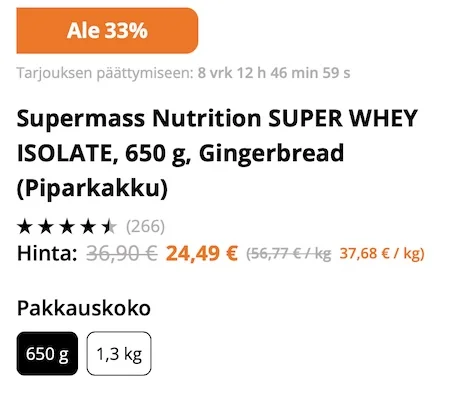On kyllä anti-protein/pro-carb bullshit sitkeässä ns. vanhan koulukunnan jäpiköissä. En tiedä miltä vuodelta tämä juttu on mutta on kyllä pahimman luokan potaskaa (tuoreet tutkimukset ovat osoittaneet, että CHO + prode on tehokkaampi kuin pelkkä CHO myös nesteyksessä, joskin mekanismi(t) ovat vielä hämärän peitossa).
Why Protein in Sports Drinks Don’t Mix [sic]
by Dr. George Brooks
"The Body's Desired Fuels During Aerobic Activities"
Some sports drinks contain proteins for one reason; those concocting them don’t know basic physiology and metabolism. Contrary to the notions of some people, proteins, and to a lesser extent, amino acids are not always appropriate for use as sports supplements and a primary example of the misuse of proteins in supplements is their inclusion in hydration beverages taken during training and competition. Here are some of the reasons for not including proteins in a sports drink:
· Proteins are not major energy sources for muscle work;
· Proteins need to be digested to amino acids before they can be absorbed from the digestive system into the blood; this makes proteins slow to be assimilated;
· Worse, inclusion of proteins slows assimilation of the other constituents in a sports drink, namely fluid, carbohydrate energy sources and electrolytes in the drink, and
· Proteins as commonly available in whey residues often taste bad; this discourages consumption of hydration beverages by athletes working hard in hot environments who sometimes need every drop of fluid they can assimilate.
The Crossover Concept[1] is the major contemporary model of fuel energy utilization during physical activity. According to this concept, in a resting postabsorptive person (i.e., someone has fasted 12-hr. overnight), fats are the major fuel in muscles and at the whole body level. In this context, proteins will represent < 10% of the energy used. But, as exercise starts, the use of fats increases somewhat, but the use of carbohydrates increases more. Then as exercise power output rises from mild to moderate, through hard and on to maximal exercise intensities, the use of carbohydrates rises exponentially. Peak fat oxidation occurs at about 45-50% max[2], and declines thereafter as the body switches (‘crosses over to’) to almost exclusive carbohydrate[3] oxidation. In working muscle biochemical processes are optimized to provide energy rapidly and with the greatest oxygen use efficiency; these mechanisms open the gates to carbohydrate use and shut the doors to use of fats, proteins and amino acids.
In addition to being poor energy sources for muscle work, proteins in the diet slow digestion and absorption. First, proteins need to be digested to amino acids, and then the amino acids need to be absorbed. In contrast to carbohydrates (lactate and sugars), electrolytes and water that are absorbed at the beginning of the small intestine, amino acids are absorbed lower down. So when vendors mistakenly add proteins to sports drinks to provide some mythical benefit, they inadvertently make the drink content more concentrated and delay absorption of the efficacious substances in the drink.
So, why include proteins in a spots drink, who knows why ?! Why give the athlete something not used and why give them something that will slow assimilation and use of the fluids, electrolytes and energy they need during activity. Certainly proteins and amino acids can be beneficial during recovery from exercise when the body’s anabolic process are heightened, but providing proteins and most amino acids during training or competition has no plausibility.
--------------------------------------------------------------------------------
Footnotes:
[1] Brooks, G.A. Importance of the “Crossover Concept” in exercise Metabolism. Clin. Exp. Pharm. Physiol. 24:889-895, 1997.
[2] Max in the sense of maximal oxygen consumption, or VO2max
[3] The carbohydrates used are: glycogen, lactate, glucose
 eli jauhe liukenee veteen. Tuote ei sisällä käyttännössä lainkaan vapaita aminohappoja erittäin korkeasta hydrolysointiasteesta huolimatta, joten tavara pysyy stabiilina nesteessä, eli sitä voi lisäravinnefirmat käyttää myös valmisjuomiin.
eli jauhe liukenee veteen. Tuote ei sisällä käyttännössä lainkaan vapaita aminohappoja erittäin korkeasta hydrolysointiasteesta huolimatta, joten tavara pysyy stabiilina nesteessä, eli sitä voi lisäravinnefirmat käyttää myös valmisjuomiin. eli jauhe liukenee veteen. Tuote ei sisällä käyttännössä lainkaan vapaita aminohappoja erittäin korkeasta hydrolysointiasteesta huolimatta, joten tavara pysyy stabiilina nesteessä, eli sitä voi lisäravinnefirmat käyttää myös valmisjuomiin.
eli jauhe liukenee veteen. Tuote ei sisällä käyttännössä lainkaan vapaita aminohappoja erittäin korkeasta hydrolysointiasteesta huolimatta, joten tavara pysyy stabiilina nesteessä, eli sitä voi lisäravinnefirmat käyttää myös valmisjuomiin.





